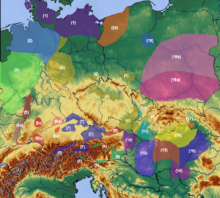Nagyrév culture
 | |
| Geographical range | Hungary and Slovakia |
|---|---|
| Period | Bronze Age |
| Dates | 3rd millennium BC – 2nd millennium BC |
| Type site | Nagyrév |
| Preceded by | Vučedol culture |
| Followed by | Hatvan culture, Vatin culture, Vatya culture |
The Nagyrév culture was a Bronze-Age culture that existed in what is now Nagyrév, Hungary. It existed alongside the Vatya culture and Hatvan cultures and was eventually superseded by the latter.[1] The main style of pottery was a one or two handed cup with a tall funnel neck that is made in a black burnished ware. The earliest phase of the culture is also known as the Makó culture.
The site
Nagyrév was located on the left bank of the Tisza which was at the western edge of a flood plain.[2] Sand dunes and other mounds of earth indicated to archaeologists that burials were done in groups, sometimes with up to 6 or 7 buried in one area.
Findings
Most burials were of cremated remains and the ashes would either be spread on the ground of the site or occasionally placed in urns. Most graves contained up to fourteen pottery pieces that held food, water and other possessions for the journey to the after life.
Pottery vessels were decorated with geometric designs with a symbolic meaning. Some pots with diamond, square or arm like looking shapes were painted around the circumference of the vessels. These burials suggest that families were buried together and even close friends to the family were buried near each other.[2]
Gallery
- Bronze necklace
- Bronze ornaments
- Bronze ornaments
- Bronze ornament
- Bronze axe
- Cups
- Cups
- Ceramic vessel
- Pottery
- Ceramic vessel.[3]
- Százhalombatta-Földvár fortified settlement site, Hungary.[4]
References
- ^ Kulcsár, Gabriella (2003). "The Early Bronze Age". In Visy, Zsolt (ed.). Hungarian Archaeology at the Turn of the Millennium (PDF). Ministry of National Cultural Heritage. p. 145. ISBN 9638629185.
Named after the Hatvan–Strázsahegy site in northern Hungary where the culture evolved, the Hatvan culture was a neighbour of the Nagyrév culture. The Hatvan culture evolved from the intermingling of earlier local communities and eastern population groups. The earliest upland settlements of the culture are known from the Cserehát Hills, lying between the Hernád–Bodrog–Sajó rivers; the culture later expanded into northern Hungary and the Tisza valley down to the Körös rivers, as well as eastern Hungary, including the Tiszazug area. Over one hundred Hatvan settlements fortified with ditches and/or ramparts, often lying at distances of no more than 5–10 km from each other, were established in the wake of this expansion. The Hatvan communities brought an end to the Nagyrév culture, and rebuilt the destroyed Nagyrév settlements according to their own tradition.
- ^ a b Marietta Csányi, "BURIALS AROUND NAGYRÉV–ZSIDÓHALOM", p. 145. Archived 2018-12-22 at the Wayback Machine. Magyar Régész Szövetség.
- ^ Pásztor, E. (2009). "The significance of the Sun, Moon and celestial bodies to societies in the Carpathian basin during the Bronze Age". The Role of Astronomy in Society and Culture, Proceedings of the International Astronomical Union, IAU Symposium. 260: 127–134. Bibcode:2011IAUS..260..127P. doi:10.1017/S1743921311002213. S2CID 140164793.
- ^ "Százhalombatta Archaeological Expedition". Hungarian National Museum.











![Ceramic vessel.[3]](https://upload.wikimedia.org/wikipedia/commons/thumb/9/95/Bronze_age_2000-1200BC_Nagyrev_culture_IMG_0995_03.JPG/102px-Bronze_age_2000-1200BC_Nagyrev_culture_IMG_0995_03.JPG)
![Százhalombatta-Földvár fortified settlement site, Hungary.[4]](https://upload.wikimedia.org/wikipedia/commons/thumb/6/68/SAXTell.JPG/110px-SAXTell.JPG)